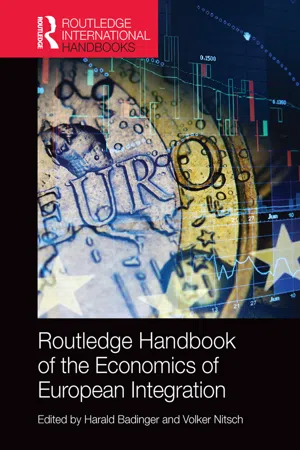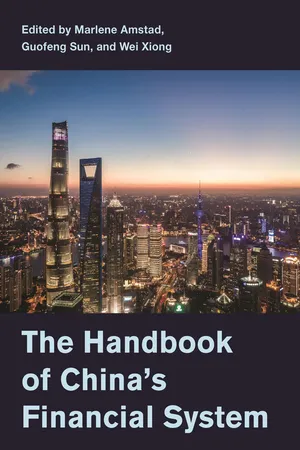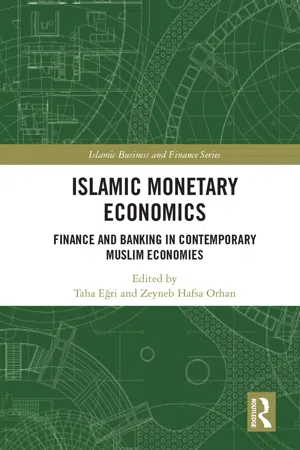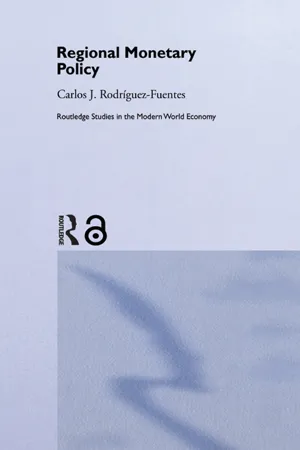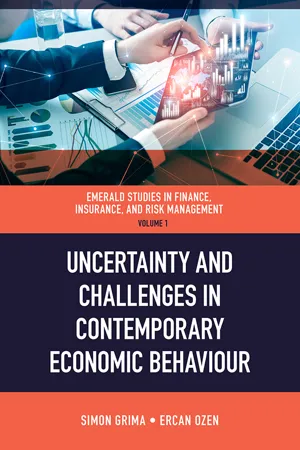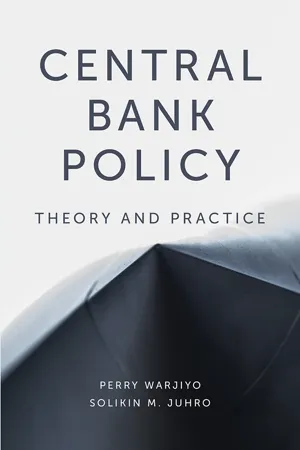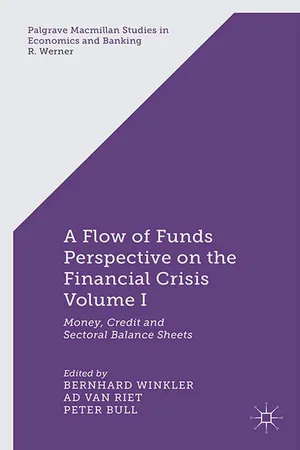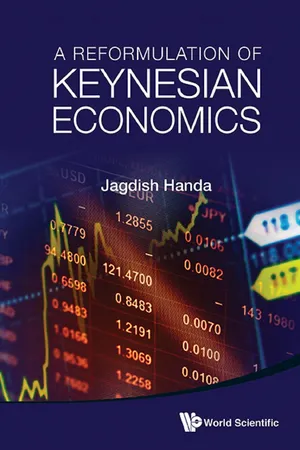Economics
Credit Channel
The credit channel refers to the mechanism through which changes in the availability and cost of credit impact economic activity. It focuses on how changes in the supply of credit by financial institutions can affect the behavior of borrowers and ultimately influence spending, investment, and overall economic performance. This concept is important for understanding the transmission of monetary policy and the functioning of financial markets.
Written by Perlego with AI-assistance
Related key terms
Related key terms
1 of 4
Related key terms
1 of 3
8 Key excerpts on "Credit Channel"
- Harald Badinger, Volker Nitsch, Harald Badinger, Volker Nitsch(Authors)
- 2015(Publication Date)
- Routledge(Publisher)
9 The Credit Channel of monetary policy in the euro area
Angela Maddaloni and José-Luis Peydró1DOI: 10.4324/9781315796918-121 Introduction
The credit provided by banks is key to fund investment and consumption. In the euro area this is particularly true since bank loans represent the large majority of the credit going to the non-financial sector (corporates and households).2 How credit provision responds to monetary policy impulses is therefore a crucial question which policy makers are generally confronted with, in particular when a financial crisis strikes.The theory of the Credit Channel of monetary policy, as defined by Bernanke and Gertler (1995 ), states that monetary policy (via monetary rates, reserve requirements but also quantitative easing) affects GDP and prices through credit. Both demand and supply of credit respond to monetary policy impulses, to different degrees, depending on the economic cycle (good or crisis times), on the type of loan and on the identity of the borrower (households, firms and banks).Figure 9.1 reports a schematic representation of how monetary channels may affect the economy through credit (see ECB, 2011 , p. 59, for all the transmission channels of monetary policy). The traditional “cost-of-capital” channel determines the demand for credit from firms and households, by determining the level of market interest rates and borrowing rates. The broad Credit Channel (as defined by Bernanke and Gertler, 1995- eBook - ePub
- Marlene Amstad, Guofeng Sun, Wei Xiong(Authors)
- 2020(Publication Date)
- Princeton University Press(Publisher)
balance-sheet channel (broad Credit Channel). The bank lending channel is based on the view that banks have a special role in the financial markets, because they are well suited to deal with asymmetric information problems in the credit market (Mishkin, 1996; Kashyap and Stein, 2000). The balance-sheet channel assumes that changes in the external finance premium amplify the direct effects of monetary policy on interest rates (Bernanke and Gertler, 1995).4.2. Empirical Assessment of the Chinese CaseThe functioning of the transmission channels discussed above is summarized mainly from the viewpoint of experiences in the advanced market economies. But as we speculated earlier, the special transition features of the Chinese economy may affect the transmission mechanisms of the monetary policy. Here we attempt to depict the way the transmission channels work by reviewing the related empirical literature. While the empirical analyses reveal quite mixed findings on almost all fronts, the general patterns are that the interest rate channel was quite weak in the earlier years but grew much stronger in recent years; that the Credit Channel is quite effective, relatively speaking; that functioning of the wealth channel is unclear, as monetary policy has distinct effects on asset prices but asset prices do not have stable impacts on consumption; and that the exchange rate channel is also not stable.In advanced market economies, interest rates are probably the most important parameters for monetary policy and financial markets. Central banks often choose short-term market interest rates as either policy tools or operational targets. In China, however, the PBC does not directly adjust or target at the short-term market rates, although it started to pay greater attention to those rates in recent years. Early economic studies find interest rates having a modest role in the Chinese economy and a weak linkage between interest rates and real sector activities. For instance, studies by Laurens and Maino (2007) and Koivu (2009) confirm that the interest rate channel does not function properly. Possible explanations for this phenomenon include the repressive financial policies: Banks’ credit allocation favors large SOEs, which still exhibit certain degrees of “soft budget constraint.” The main borrowers are less sensitive to changes in interest rates, while the interest rate sensitive sectors, such as private firms, are either discriminated against or altogether excluded from formal financial services. - eBook - ePub
Islamic Monetary Economics
Finance and Banking in Contemporary Muslim Economies
- Taha E?ri, Zeyneb Hafsa Orhan(Authors)
- 2020(Publication Date)
- Routledge(Publisher)
By reviewing the theoretical literature, we find that the traditional monetary policy theories have mainly emphasized the control of money supply to make changes in the interest rate and levels of spending in the economy (Friedman and Schwartz, 1963; King and Plosser, 1984; Sim, 1992), although the importance of financial intermediaries, particularly banks, is highly highlighted by new theories of monetary policy (Bernanke and Gertler, 1995). The role of the banking sector in the monetary policy transmission process depends on how much banks rely on deposits, how much consumers and business firms are bank dependent, and how much bank credit expansion is affected by monetary policy shocks.Mishkin (1996) is the first one who seems to be dissatisfied with the performance of conventional interest rate channels and, perhaps for the first time, systematically introduced the role of asymmetric information in financial markets, which led to the Credit Channel in two different ways in credit markets. The first one is the balance sheet channel, and the second one is the bank-lending channel, which is also known as the credit supply channel of banks. By reviewing a vast amount of empirical literature, we find that several well-known scholars have provided strong evidence confirming the transmission process of monetary policy through these two channels for different economies across the globe. Examples of these researchers include, among several others, Kashyap and Stein (1994), Bernanke and Gertler (1995), and Cecchetti (1999).After the 2007–08 financial crisis, the credit supply channel of banks, which is known as the “bank-centric view of monetary transmission”, came to the forefront because the banking sector was affected badly. According to the bank-centric view of monetary policy transmission mechanism, money, bonds, and bank loans are assumed to be three important financial assets in the economy. The functioning of the credit supply channel of monetary transmission mechanism mainly relies on the assumption that during periods of monetary tightening policy, the aggregate lending by banks slows down, and non-banking financing such as commercial papers increases. A monetary tightening drains reserves from the banking sector, which in turn weakens banks’ deposit base. Hence, banks are expected to be unable to issue new loans and even perhaps to continue with their existing lending projects without using external sources of finance such as equity, debt, or commercial paper issuance (Gertler and Gilchrist, 1993; Kashyap and Stein, 1994; Cecchetti, 1999). - eBook - ePub
- Carlos Javier Rodriguez Fuentes(Author)
- 2005(Publication Date)
- Routledge(Publisher)
16The new Keynesians have also paid attention to the role of credit in the transmission mechanism of monetary policy. This literature is usually known as the lending or credit view and, contrary to the traditional ‘money view’ that sees monetary policy operating exclusively only through changes in interest rates, it maintains that monetary policy might make access to credit more difficult or expensive for some borrowers when there exist credit market imperfections.17 According to this view, monetary policy ‘…will affect the level of investment, not through the interest-rate mechanism, but rather through the availability of credit’ (Stiglitz and Weiss 1981:409). Consequently, the transmission mechanism implicit in the textbook IS-LM model is rejected, since it does not take into account such capital market imperfections.18The assumption that capital markets are imperfect leads to the inclusion of two additional channels in the transmission of the monetary policy, namely the balance sheet channel and the lending channel (Bernanke and Gertler 1995). A large amount of empirical evidence exists which supports the relevance of these two original channels,19 and could be complemented with the much more recent ‘capital channel’ (Van den Heuvel 2002a, 2002b).This literature is concerned with the existence of credit rationing when capital markets fail to work properly. It is therefore when capital markets are incomplete that the banking system becomes important for the transmission of the monetary policy, due to several factors. From the bank lending channel perspective, monetary policy may affect credit availability to some kinds of borrowers (those most dependent on banks) when banks do not have close substitutes for bank loans in the asset side of the bank’s balance sheet. On the other hand, the ‘balance sheet channel’ (also known as the financial accelerator) might reinforce monetary policy through their effects on the financial structure of economic agents. Finally, the ‘bank capital channel’ suggests that monetary policy might also influence lending through its impact on bank equity capital (Van den Heuvel 2002a, 2002b). Overall, what this literature suggests is that banks are important for the ‘transmission mechanism’ of the monetary policy because they provide credit and monetary policy affects credit availability when capital markets are imperfect. - Ercan Özen, Simon Grima(Authors)
- 2020(Publication Date)
- Emerald Publishing Limited(Publisher)
Findings: In the study relation between the variables has been analyzed under two parts via harnessing Toda–Yamamoto casualty test. In the first part, results of Toda–Yamamoto causality test from RGDP, GSSO and interest rate (FO) variables have been presented. The results manifest that interest channel directly affects direct fixed capital investment and RGDP. Interest channel was found to be effective on these variables of the analysis. In the second part, Toda–Yamamoto causality test was harnessed for SUE, YUFE and FO variables. Interest channel did not provide a result that affected YUFE and SUE.Keywords : Turkish economy; monetary policy; monetary transmission mechanism; interest channel; Zivot–Andrews unit root test; Toda–Yamamoto causality testJEL classification: E42; E52; E581. Introduction
Finance and monetary policy are the two economy policies that complement each other. Finance policy refers to state-led formation of income and expenditure policies in alignment with specific objectives such as economic growth and development. Monetary policy relates to compilation of resolutions issued by central banks to meet specific economic goals via utilizing policy tools. Policy resolutions of central banks necessitate harnessing appropriate and effective policy tools in order to steer national economy.Transmission mechanism means monetary transfer from financial markets to real market as a result of resolutions on monetary policy. The way functioning of this mechanism can affect macroeconomic variables is vitally important. Therefore, it is mandatory that to reach their objectives authorities of money implement appropriate policy tools. Despite being a powerful tool, monetary policy may occasionally result in unexpected outcomes. Furthermore, to ensure success in the execution of monetary policy, it is a must to correctly analyze timing and effect of this policy on economy (Mishkin, 1995 , p. 4).As regards national economies, there may be a divergence from state to state in the functioning of their monetary transmission mechanism. This divergence is bound to economic parameters such as financial structure of a state, index of openness and its role in global economy. In order to exhibit potential effects of real policy tools that central banks implement to ensure financial stability on a national economy, there has been a rapid rise as of 1980s in the studies that manifested the functioning of monetary transmission mechanism. Monetary transmission mechanism has thus been harnessed to the end of examining how and why monetary changes can direct a national economy, and through which ways it can shape national production, total demand and the key problem-inflation . After 2008 global crisis caused by the instability of financial markets in global economy, the salient role of monetary transmission mechanism has been accentuated even further (Central Bank of Turkey (CBT), 2012- eBook - ePub
Central Bank Policy
Theory and Practice
- Perry Warjiyo, Solikin M. Juhro(Authors)
- 2019(Publication Date)
- Emerald Publishing Limited(Publisher)
The business scale is usually small and medium enterprises, which do not meet the requirements to issue stocks or bonds on the capital market. Therefore, the banks could face funding shortfalls if the central bank tightened its monetary policy stance because retail funding is not normally sensitive to the interest rate, while a dip in income could reduce bank funding. Consequently, the banking industry would ration more credit, with small and medium borrowers most affected. 9 Bernanke and Blinder (1988) demonstrated that monetary policy will tend to amplify the real economy under such a bank credit and funding structure, implying that credit will be too tight when the economy experiences a downswing and too loose during an economic upswing. 5.4.1.2. Bank Capital Channel. Bank capital also affects credit supply. Van den Heuvel (2002) studied the impact of the CAR and ability of banks to issue shares. Bank capital could be influenced by the ability to generate profit, the market price assessment of net assets on the balance sheet and the mandatory reserves required to mitigate credit risk and default of the securities held. The ability of a bank to issue shares on the capital market also affects bank capital. More bank capital implies greater lending capacity. Capital constraints in terms of credit supply become more binding if the level of capital approaches or falls below the capital requirements set by the central bank or relevant supervisory authority. Such factors in the bank lending and capital channels influence the supply behavior of banks. In general, the bank supply function is determined not only by the lending rate (r k) and economic outlook (y), but also by credit risk (ρ k) liquidity (LDR) and capital (CAR) at each respective bank as follows: In the credit supply function (16), banks may set different lending rates for different borrowers depending on the cost of monitoring (c i) and credit risk (ρ k i), despite the same funding rate (r d) - eBook - ePub
A Flow-of-Funds Perspective on the Financial Crisis Volume I
Money, Credit and Sectoral Balance Sheets
- B. Winkler, A. van Riet, P. Bull, B. Winkler, A. van Riet, P. Bull, Kenneth A. Loparo, B. Winkler, A. van Riet, P. Bull, Ad van Riet(Authors)
- 2013(Publication Date)
- Palgrave Macmillan(Publisher)
4 Thus, banks are in the driver’s seat, deciding about the quantity of credit (and hence money supply) created, and its allocation for which type of transactions. These decisions are central to the economy and, indeed, will quickly reshape the entire economic landscape.Of course, these decisions by banks are not made in a vacuum. The single biggest factor influencing bank behaviour is the bank regulation administered by the central bank and other regulatory authorities. Another crucial factor is the design of the banking system, including the incentive structure prevalent within each bank. However, as far as other actors are concerned, bank credit is an exogenous variable, and policy can be applied to shape it.3.5 Good and bad credit creationThe disaggregation of economic activity into ‘real’ economy circulation and financial circulation, which is at the heart of both QTC and FoF analysis, requires that we consider the source of gains in each sphere. This is also of importance for the interpretation of any quantitative analysis of equations (3.5) and (3.6). According to equation (3.3), we consider ‘real’ economy transactions accurately measured by nominal GDP. The latter is a measure of value added, equivalent to national income. The concept of national income implies that transactions occur which are linked to income streams. This, indeed, is a fundamental difference from the financial accounts and financial transactions: they are not linked to underlying genuine income streams. In aggregate, returns from financial transactions are instead due to capital gains, which are a function of price changes, which in turn are driven by bank credit creation for financial transactions (equation 3.6).But capital gains are a zero-sum game, while national income is a positive sum game. This has implications for sustainability and stability. One implication is that only credit to fund income-generating transactions that contribute to GDP is sustainable, since the income can be used to service the debt and repay the principal. This is the type of credit that Schumpeter (1912) considered. But it is not the only type, and is often dwarfed by the other two types: credit for GDP transactions that are not of an income-generating type (such as consumer credit), and credit for financial transactions, which may generate capital gains. These types are thus intrinsically unsustainable. Concerning financial transactions, in aggregate and over time capital gains from them are zero. Positive sum gains can be induced for a time only by an increase in credit creation for financial transactions, which, according to equation (3.6), determines and in this example pushes up asset prices, and hence generates further credit-driven capital gains without any underlying increase in income streams. However, these gains are matched by subsequent capital losses, restoring the zero balance over time, in what is nothing but a Ponzi scheme. - eBook - ePub
- Jagdish Handa(Author)
- 2015(Publication Date)
- WSPC(Publisher)
A major objective of this chapter has been to offer a macroeconomic framework for studying the role of credit in the economy and of the impact of a credit crisis. Credit enters into both the demand and supply structures of the economy and, therefore, into the equilibrium condition for each sector of the economy. It is a determinant of consumption, investment and exports and therefore of commodity demand. It also enters into the money demand and supply equations. On the money supply side, it determines the multiplier between the monetary base and the money supply. On the AS of commodities, credit affects the short-term supply of commodities and the demand for labor. Wherever credit affects other variables, both its interest rate and the degree of credit rationing by quantity have an impact. Consequently, our analysis implies that, in the short term, credit booms boost economic activity and credit crises lead to declines in economic activity.In the economy as a whole, there is two-way causality between each pair of variables among output, money, and financial capital. Therefore, exogenous shocks to output produce changes in the money supply and the cost and availability of credit and bonds, while exogenous shocks in financial markets produce changes in output.43 To illustrate this two-way relationship, an adverse credit shock resulting in a recession worsens firms’ balance sheets and households’ job prospects, which, through a feedback loop, further worsens credit conditions and reduces real output — and vice versa. These feedback effects from output changes on credit, therefore, amplify and increase in duration the impact of both credit and real shocks on the economy.44A credit crisis achieves greater importance when the adverse shocks to credit markets, especially to its supply, are sufficiently acute and of a long enough duration to produce decreases in output. The impact of a credit crisis is likely to be greater than that which would be observable in the general equilibrium solution of the model, since it is likely to force the economy into disequilibrium, i.e., produce excess or deficient demand relative to the general equilibrium output for significant chronological period of time. Further, since in our approach, a financial crisis affects output through the AS of output, in addition to that throughAD, the impact of the financial crisis on output and employment is likely to have longer chronological duration than if the effect was only through the demand side of the economy. For the USA, the financial crashes of 1929–1930 and 2007–2008, followed by slow recoveries, seem to illustrate the implications derived in this paper. Further, the very different duration and severity of the fall in output and employment experienced in the Great Depression versus that in the Great Recession and after it seem to reflect the drastic differences in the credit and monetary policies pursued in those two episodes.
Index pages curate the most relevant extracts from our library of academic textbooks. They’ve been created using an in-house natural language model (NLM), each adding context and meaning to key research topics.
Explore more topic indexes
Explore more topic indexes
1 of 6
Explore more topic indexes
1 of 4
